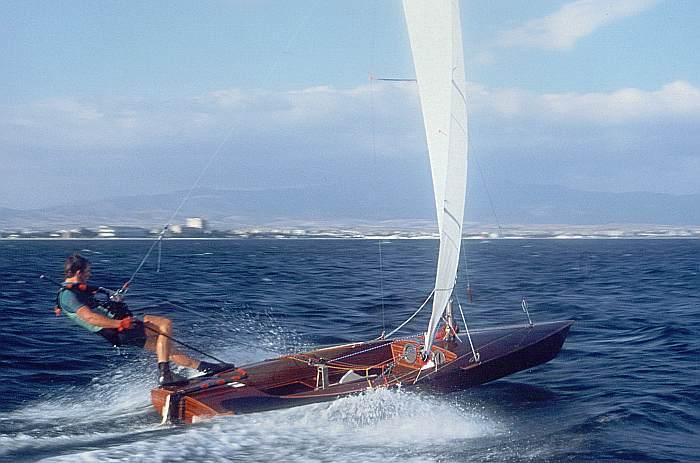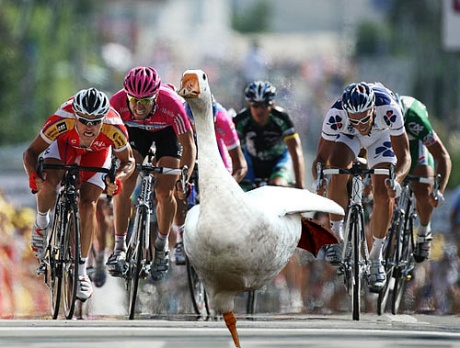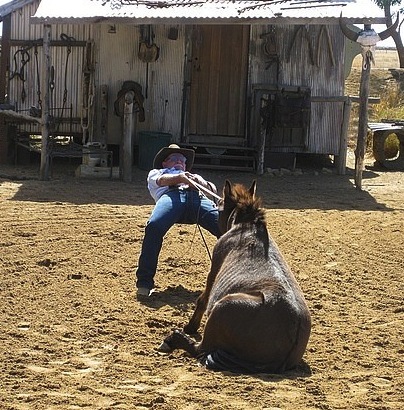Archive for the ‘The Future’ Category
The Illusion of Control
 When things don’t go as planned, you have a choice – look outside or look inside. Looking outside is about control and looking inside is about lack of control.
When things don’t go as planned, you have a choice – look outside or look inside. Looking outside is about control and looking inside is about lack of control.
When you look outside, what you’re saying is the universe didn’t behave per the plan, and you’re going to teach it a lesson. You’re going to tighten the screws until it does what you want; you’re going to add personal energy (probably all your energy) to lock things down; you’re going to control what must be controlled so the universe follows your plan.
The look outside approach can work, for a while. You can put your fingers and toes in all the holes; you can make sure everyone does their job; and you can be the master scheduler for the universe, but only for a while because the universe has limitless energy and you don’t. And while your control-the-world strategy looks like it’s working, it’s not – not even in the short term. The universe is playing you – it’s sucking your energy while you tread water. The universe isn’t stupid – it knows you can’t last. But at its core, the universe likes to teach; and when you fight it head-to-head, it wants to teach you about opportunity cost. While you spend all your energy wresting it to a draw, it prevents you from moving forward. It wants you to learn you have finite energy and to be thoughtful about how you spend it.
When you look inside, what you’re saying is the universe didn’t behave per the plan, and didn’t think it would. You’re going to learn from the universe and work with it; you’re going to surf the wave of the universe’s energy and carve a cross product with its momentum; you’re going to adjust your plan because you have a lack of control over the universe and most other things.
The look inside approach is effective in the long term because it works with the natural trade winds of the universe. Sailing downwind takes far less energy than tacking into the teeth of the cosmic winds, and it’s faster. This is the lesson the universe wants you to learn. But it’s not that easy. The universe constantly tests you. It changes wind direction without our consent and watches. Will you look outside or inside? Will you tack into the wind or change course and throw a huge bow wave as you go?
The toughest part isn’t the wind; it’s the other sailors. They’ve been trained over the years to tack quickly and tack often, to sail directly toward the destination regardless of the wind, even if they must grab the oars and break their backs into the wind. For those sailors, a course change is a sign of weakness – real sailors battle the wind; real sailors stay the course even if the great circle route is faster.
Thing is, plans never happen as planned, and yours is no different. Yes, control things that can be controlled, but remember – the uncontrollable can’t be controlled just because you want them to be. The universe has been around a long time and knows the ropes. It knows you don’t have control over it; it knows you only have control over how you respond to it.
When you work hand-in-hand with the universe, it rewards you, though it does so obliquely. So if your winds suddenly change and you have to sail away from your grand destination, don’t despair – that’s the universe rewarding good behavior. Double the watch and scan the horizon for the uncharted island with far more treasure than you thought possible. The universe calls that karma.
Image courtesy of YachtPals.com
Seeking Comfort in Discomfort
 There’s a natural desire to create comfort because, well, it’s comfortable. The parents of comfort are sameness and familiarity. To be comfortable we naturally seek out familiarity, and since we’re most familiar with what we did last time, we naturally want to repeat the past. Because we’re familiar with it and because the familiarity makes us comfortable, there’s natural gravitational pull toward the past. Same goes for sameness – it’s comfortable so we seek it out. That’s why there’s so much momentum around what we did last time – familiarity and sameness create comfort and comfort feels comfortable.
There’s a natural desire to create comfort because, well, it’s comfortable. The parents of comfort are sameness and familiarity. To be comfortable we naturally seek out familiarity, and since we’re most familiar with what we did last time, we naturally want to repeat the past. Because we’re familiar with it and because the familiarity makes us comfortable, there’s natural gravitational pull toward the past. Same goes for sameness – it’s comfortable so we seek it out. That’s why there’s so much momentum around what we did last time – familiarity and sameness create comfort and comfort feels comfortable.
And there’s a second level of intellectual inertia created by our desire for comfort. Yes, the parents are the same – sameness and familiarity – but this level of comfort is about comfort with what we have. Whatever success we’ve had, we want to hold onto it so we can feel comfortable. It’s the success we know, it’s what we’re familiar with, and we want sameness around success.
Level one is about comfort around our behavior and level two is about comfort around outcomes of our behavior. We do what we did last time because we know how to do it and we extrapolate – because we did it well last time we’ll do it well this time. We do what we did last time because it worked and we extrapolate – because it worked last time it will work well again. And when the past is repeated, we’ll be comfortable.
This is a fine way to go if things are static – when the rules of the past are the same in the future. But the wheels fall off when things are dynamic – extrapolation doesn’t work when the rules change,and surely we live in dynamic times. If there’s one thing we should be uncomfortable with it’s seeking comfort in familiarity and sameness.
Just as comfort fosters sameness, discomfort drives disruption.
No doubt the future’s rules will be different, and discomfort will be the forcing function. Discomfort with the status quo will propel upstarts to innovate and break rules. For them familiarity and sameness are uncomfortable, and since they too are human, they will seek out comfort. But they will find it in unfamiliarity and difference. They will be comfortable when they disrupt the game, dethrone the leaders, and coronate themselves.
Whether you’re the leader or the start-up, increase your level of discomfort. The leader can create pockets of discomfort (financed by comfort-based success) to break the rules on their own terms and obsolete their best stuff on their own timeline. And the already uncomfortable start-up can add more to harden itself for the tough times ahead.
Maximizing comfort does not maximize business success. There is little learning without discomfort and there is no adaptation without it. If you’re feeling comfortable, that’s the telltale sign you shouldn’t.
Acceleration Is King
 Everything is about speed – speed through process reengineering, waste elimination, standardization, modularity, design reuse. All valid, but not all that powerful. Real speed comes from avoiding rapid progress in the wrong direction, from avoiding a blistering pace on the wrong stuff. Real speed comes from saying no to the work that creates drag in order to say yes to work that accelerates.
Everything is about speed – speed through process reengineering, waste elimination, standardization, modularity, design reuse. All valid, but not all that powerful. Real speed comes from avoiding rapid progress in the wrong direction, from avoiding a blistering pace on the wrong stuff. Real speed comes from saying no to the work that creates drag in order to say yes to work that accelerates.
It’s healthy to have time limits and due dates, finite resources, and budgets. These constraints are helpful because they force a cutoff decision: what work will get done and what won’t. And thankfully, all businesses have them – take them away and eliminate all hope of profitability and sustainability. But from a speed perspective, sometime we look at them in a backward way.
Yes, that work would change the game, but we don’t have time. That argument is a little misleading. Truth is, there’s the same amount of time as last year – a week is still a week, and there are still 52 of them in a year. It’s not about time; it’s about the work done during that time. With a backwards view, the constraint calls attention to work won’t get done, but the constraint is really about work that will get done. If the work that doesn’t make the cut is less magical than the work that does, the constraint creates a speed problem – too slow on the game-changing work. The speed problem is realized when the new kid on the block makes magic and you don’t. If the constraint helps say yes to magic and no to lesser work, there’s no speed problem.
Yes, we could reinvent the industry, but we don’t have resources. No, we have resources. But the constraint isn’t really about resources, it’s about the work. And not any old work, the constraint is about the work that will get done. (Not the work that won’t.) If the constraint causes us to stuff our fingers in the holes in the dyke at the expense of eliminating it altogether, the constraint caused a speed problem. It’s a problem because while we’re plugging holes, an eager competitor will dismantle the need for the dyke. Speed problem.
Sure, we’d leapfrog the competition, but we don’t have the budget. No, we have a budget. But, like the other constraints, the budgetary one is also about the work that will get done. If the constraint prioritizes same-as-last-time over crazy, it creates a speed problem. New competitors who don’t have to protect the old guard products will work on crazy and bring it to market. And that’s a problem because you’ll have more of what you’ve always had and they’ll have crazy.
Yes, in all cases, choose the bigger bet. Choose crazy over sane, magical over mundane, and irregular over regular. And choose that way because it’s faster. And here’s why faster is king: The number of countries with a well educated work force is growing; there’s an ever increasing number of micro companies who can afford to bet on disruptive technologies; and the internet has shown the world how their lives could be and created several billion people who will use their parental fortitude to do whatever it takes to make life better for their kids. (And there’s no stronger force on earth.) And it all sums to an incredible amount of emotional energy relentlessly pushing the pace.
The world isn’t just getting faster, it’s accelerating – yes, next month will be faster than this month, but that’s not the real trick with acceleration. With acceleration the faster things get, the faster they get faster. Is there really any question how to use your constraints?
Wrestle Your Success To The Ground
 Innovation, as a word, has become too big for its own good, and, as a word, is almost useless. Sure, it can be used to enable magical reinvention of business models and revolutionary products and technologies, but it can also be used to rationalize the rehash work we were going to do anyway. The words that send angry chills down the back of the would-be-innovative company – “We’re already doing it.”
Innovation, as a word, has become too big for its own good, and, as a word, is almost useless. Sure, it can be used to enable magical reinvention of business models and revolutionary products and technologies, but it can also be used to rationalize the rehash work we were going to do anyway. The words that send angry chills down the back of the would-be-innovative company – “We’re already doing it.”
When company leaders talk about doing more innovation, there’s a lot of pressure in the organization to point to innovative things already being done. The organization misinterprets the desire for more innovation as a negative commentary on their work. The mental dialog goes like this – We’re good at our work, we’re working as hard as we can, and we’re doing all we can to meet objectives – hey, look at this innovative stuff we’re doing. Clearly this isn’t what company leaders are looking for, but the word does have that influence.
What can feel better is to describe what is meant by innovation. Wherever we are, whatever successes we’ve had, we want to change our behaviors to create new, more profitable business models; create new products and technologies that obsolete our best, most profitable ones; and change our behaviors to create new, more profitable markets. The key is to acknowledge that our existing behaviors are the very thing that has created our success (and thank them for it), and to acknowledge the desire to build on our success by obsoleting it. When we ask for more innovation, we’re asking for new behaviors to dismantle our current day success behind us to create the next level of success.
There’s a tight link to innovation and failure – risk, learning, experimentation – but there’s a missing link with success. Acknowledgement of success helps the organization retain its self worth and helps them feel good about trying new stuff. However, even still, success is huge deterrent to innovation. Company success will retain the behaviors that created it, and more strongly, as new behaviors are injected, the antibodies of success will reject them. Our strength becomes our weakness.
Strong technologies become anchors to themselves; successful, stable, long-running markets hold tightly to resources that created them; and time-tested business models are above the law. New behaviors almost don’t stand a chance.
Fear of losing what we have is the number one innovation blocker. Where failure blocks innovation narrowly in the blast zone, success smears a thick layer of inaction across the organization. What’s most insidious, since we celebrate success, since we laud customer focus, since we track and reward efficiently doing what we’ve done, we systematically thicken and stiffen the layer that gums up innovation.
Instead of starting with a call-to-arms for innovation, it’s best to define company values, mission, and strategic objectives. Then, and only then, define innovation as the way to get there. First company objectives, then innovation as the path.
Innovation, as a word, isn’t important. What’s important are the new behaviors that will wrestle success to the ground, and pin it.
Starvation, Pressure, and Perspective Shift
I like Dave Snowden’s thinking on innovation – starvation, pressure, and perspective shift. Here’s what it means to me:
Starvation – Left to our own, we’ll do as we did before. Starvation of resources pushes thinking away from stale, worn paths. Almost in reverse, define what you don’t want, then construct intelligent constraints (the most difficult part of the whole deal) so it’s out of the design space. Constrain the team so they can’t use the most expensive material; constrain the team so they can’t use the same old technology; constrain them so they can’t use the tried and true business model. It’s reverse thinking, but constraints – telling them what they can’t do – frees up design space. Constraints say “Do anything you want, except this.” which constrains far less than specifications. Constrain them to free them.
Pressure – Left to our own, we’ll reuse old thinking. Time pressure drags thinking out of the ruts of our success. Define creative constraints then, to create pressure, give the team insufficient time to think it through. Force them to swim differently with the problem. The best way I know is to explain the constraints then give the team fifteen minutes to build a prototype. (Yes, fifteen.) The prototype is non-functional, and can be made from whatever is on hand – cardboard, clay, duct tape, or packing peanuts. The short time frame creates pressure, and the pressure extrudes different thinking. Building a prototype shifts from learning-in-the-brain to learning-with-the-hands. And since hands learn differently than brains, new thinking is cast.
Perspective Shift – Left to our own, we’ll do a remake. Perspective shift moves us to a different place to create a healthy disrespect for today’s thinking. Seen in the right new light, our successes should look problematic. (From the front a skunk isn’t so bad, but from behind things aren’t so good.) Building a bridge to a new perspective can shift things a little, but for a tectonic shift, formalize the consequences of inaction. Think – “If we don’t do this, a very bad thing will happen.” Perspective shift is all about creating action in a new direction.
You won’t get it right the first time, but, no matter. The real enemy is inaction.
A Healthy Dissatisfaction With Success
 They say job satisfaction is important for productivity and quality. The thinking goes something like this: A happy worker is a productive one, and a satisfied worker does good work. This may be true, but it’s not always the best way.
They say job satisfaction is important for productivity and quality. The thinking goes something like this: A happy worker is a productive one, and a satisfied worker does good work. This may be true, but it’s not always the best way.
I think we may be better served by a therapeutic dose of job dissatisfaction. Though there are many strains of job satisfaction, the most beneficial one spawns from a healthy dissatisfaction with our success. The tell-tale symptom of dissatisfaction is loneliness, and the invasive bacterium is misunderstanding. When the disease is progressing well, people feel lonely because they’re misunderstood.
Recycled ideas are well understood; company dogma is well understood; ideas that have created success are well understood. In order to be misunderstood, there must be new ideas, ideas that are different. Different ideas don’t fit existing diagnoses and create misunderstanding which festers into loneliness. In contrast, when groupthink is the disease there is no loneliness because there are no new ideas.
For those that believe last year’s ideas are good enough, different ideas are not to be celebrated. But for those that believe otherwise, new ideas are vital, different is to be celebrated, and loneliness is an important precursor to innovation.
Yes, new ideas can grow misunderstanding, but misunderstanding on its own cannot grow loneliness. Loneliness is fueled by caring, and without it the helpful strain of loneliness cannot grow. Caring for a better future, caring for company longevity, caring for a better way – each can create the conditions for loneliness to grow.
When loneliness is the symptom, the prognosis is good. The loneliness means the organization has new ideas; it means the ideas are so good people are willing to endure personal suffering to make them a reality; and, most importantly, it means people care deeply about the company and its long term success.
I urge you to keep your eye out for the markers that define the helpful strain of loneliness. And when you spot it, I hope you will care enough to dig in a little. I urge you think of this loneliness as the genes of a potentially game-changing idea. When ideas are powerful enough to grow loneliness, they’re powerful enough to move from evolutionary into revolutionary.
The Middle Term Enigma
 Short term is getting shorter, and long term is a thing of the past.
Short term is getting shorter, and long term is a thing of the past.
We want it now; no time for new; it’s instant gratification for us, but only if it doesn’t take too long.
A short time horizon drives minimization. Minimize waste; reduce labor hours; eliminate features and functions; drop the labor rate; cut headcount; skim off the top. Short term minimizes what is.
Short term works in the short term, but in the long term it’s asymptotic. Short term hits the wall when the effort to minimize overwhelms the benefit. And at this cusp, all that’s left is an emaciated shadow of what was. Then what? The natural extrapolation of minimization is scary – plain and simple, it’s a race to the bottom.
Where short term creates minimization, long term creates maximization. But, today, long term has mostly negative connotations – expensive, lots of resources, high risk, and low probability of success. At the personal level long term, is defined as a timeframe longer than we’re measured or longer than we’ll be in the role.
But, thankfully, there comes a time in our lives when it’s important for personal reasons to inject long term antibodies into the short term disease. But what to inject?
Before what, you must figure out why you want to swim against the current of minimization. If it’s money, don’t bother. Your why must have staying power, and money’s is too short. Some examples of whys that can endure: you want a personal challenge; you want to help society; your ego; you want to teach; or you want to help the universe hold off entropy for a while. But the best why is the work itself – where the work is inherently important to you.
With your why freshly tattooed on your shoulder, choose your what. It will be difficult to choose, but that’s the way it is with yet-to-be whats. (Here’s a rule: with whats that don’t yet exist, you don’t know they’re the right one until after you build them.) So just choose, and build.
Here are some words to describe worthwhile yet-to-be whats: barely believable, almost heretical, borderline silly, and on-the-edge, but not over it. These are the ones worth building.
Building (prototyping) can be expensive, but that’s not the type of building I’m talking about. Building is expensive when we try to get the most out of a prototype. Instead, to quickly and efficiently investigate, the mantra is: minimize the cost of the build. (The irony is not lost on me.) You’ll get less from the prototype, but not much. And most importantly, resource consumption will be ultra small – think under the radar. Take small, inexpensive bites; cover lots of ground; and build yourself toward the right what.
Working prototypes, even crude ones, are priceless because they make it real. And it’s the series of low cost, zig-zagging, leap-frogging prototypes that make up the valuable war chest needed to finance the long campaign against minimization.
Short term versus long term is a balancing act. Your prototype must pull well forward into the long term so, when the ether of minimization pulls back, it all slides back to the middle term, where it belongs.
Circle of Life
Engineers solve technical problems so
Other engineers can create products so
Companies can manufacture them so
They can sell them for a profit and
Use the wealth to pay workers so
Workers can support their families and pay taxes so
Their countries have wealth for good schools to
Grow the next generation of engineers to
Solve the next generation of technical problems so…
A Race for Learning – Video Training with TED-Ed
 I’ve been thinking about how to use video to train engineers. The trouble with video is it takes time and money to create. But what if you could create lessons using existing video? That’s what the new TED-Ed platform can do. With TED-Ed, any YouTube video can be “flipped” into a customized lesson.
I’ve been thinking about how to use video to train engineers. The trouble with video is it takes time and money to create. But what if you could create lessons using existing video? That’s what the new TED-Ed platform can do. With TED-Ed, any YouTube video can be “flipped” into a customized lesson.
Instead of trying to describe it, I used the new platform to create a video lesson. Click the link below and give it a try. (The platform is still in beta version, so I’m not sure how will go. But that’s how it is with experiments.)
Video lesson: Innovation, Caveman-Style
When answering the questions, it may ask you to sign up for an account. Click the X in the upper right of the message to make it go away, and keep going. If the video does not work at all, poke around the TED-Ed website.
Either way, so we can accelerate our learning and get out in front, please post a comment or two.
Beyond Dead Reckoning
 We’re afraid of technology development because it’s risky. And figuring out where to go is the risky part. To figure out where to go companies use several strategies: advance multiple technologies in parallel; ask the customer; or leave it to company leader’s edict. Each comes with its strengths and weaknesses.
We’re afraid of technology development because it’s risky. And figuring out where to go is the risky part. To figure out where to go companies use several strategies: advance multiple technologies in parallel; ask the customer; or leave it to company leader’s edict. Each comes with its strengths and weaknesses.
I think the best way to figure out where to go is to figure out where you are. And the best way to do that is data-driven S-curve analysis.
To collect data, look to your most recent product launches, say five, and characterize them using a goodness-to-cost ratio. (Think miles per gallon for your technology.) Then plot them chronologically and see how the goodness ratio has evolved – flat, slow growth, steep growth, or decline. The shape of the curve positions your technology within the stages of the S-curve and its location triangulated with contextual clues. You know where you are so you can figure out where to go.
Here’s what the stages feel like and what to do when you’re in them:
Stage 1: Infancy – New physics are used to deliver a known function, but it’s not ready for commercialization. This is like early days of the gasoline-electric hybrid vehicles, where the physics of internal combustion was combined with the physics of batteries. In Stage 1 the elements of the overall system are established, like when Honda developed its first generation Honda Insight and GM its EV1. Prototypes are under test, and they work okay, but not great. In Stage 1, goodness-to-cost is lower than existing technologies (and holding), but the bet is when they mature goodness-to-cost will be best on the planet.
If your previous products were Stage 4 (Maturity) or Stage 5 (Decline), your new project should be in Stage 1. If your existing project is in Stage 1, focus on commercialization. If all your previous projects were (are) in Stage 1, you should focus on commercializing one (moving to Stage 2) at the expense of starting a new one.
Stage 2: Transitional – A product is launched in the market and there is intense competition with existing technologies. In Stage 2, several versions of new technology are introduced (Prius, Prius pluggable, GM’s Volt, Nissan Leaf), and they fight it out. Goodness-to-cost is still less than existing technologies, but there’s some element of the technology that’s attractive. For electric vehicles, think emissions.
If your previous products were Stage 4 (Maturity) or Stage 5 (Decline) and your current project just transitioned from Stage 1, you’re in the right place. In Stage 2, fill gaps in functionality; increase controllability – better controls to improve battery performance; and develop support infrastructure -electric fueling stations.
Stage 3: Growth – Goodness-to-cost increases rapidly, and so do sales. (I think most important for an electric vehicle is miles per charge.)
If you’re in Stage 3, it’s time to find new applications – e.g., electric motorcycles, or shorten energy flow paths – small electric motors at the wheels.
Stage 4: Maturity – The product hits physical limits – flat miles per gallon; hits limits in resources – fossil fuels; hits economic limits – costly carbon fiber body panels to reduce weight; or there’s rapid growth in harmful factors – air pollution.
If you’re in Stage 4, in the short term add auxiliary functions – entertainment systems, mobile hotspot, heated steering wheel, heated washer fluid; or improve aesthetics – like the rise of the good looking small coupe. In the long term, start a Stage 1 project to move to new physics – hydrogen fuel cells.
Stage 5: Decline – New and more effective systems have entered their growth stage – Nissan Leaf outsells Ford pickup trucks.
If you’re in Stage 5, long ago you should have started at Stage 1 project – new physics. If you haven’t, it may be too late.
S-curve analysis guides, but doesn’t provide all the answers. That said, it’s far more powerful than rock-paper-scissors.
(This thinking was blatantly stolen from Victor Fey’s training on Advanced S-Curve Analysis. Thank you, Victor.)
The Pilgrimage of Change
 The pilgrimage of change is hard.
The pilgrimage of change is hard.
Before we start, we must believe there’s a way to get there.
Before that, we must believe in the goodness of the destination.
Before that, we must believe there’s a destination.
Before that, we must want something different.
Before that, we must see things as they are.
Before that, we must want to understand.
Before that, we must be curious.
And to do that, we must believe in ourselves.


 Mike Shipulski
Mike Shipulski